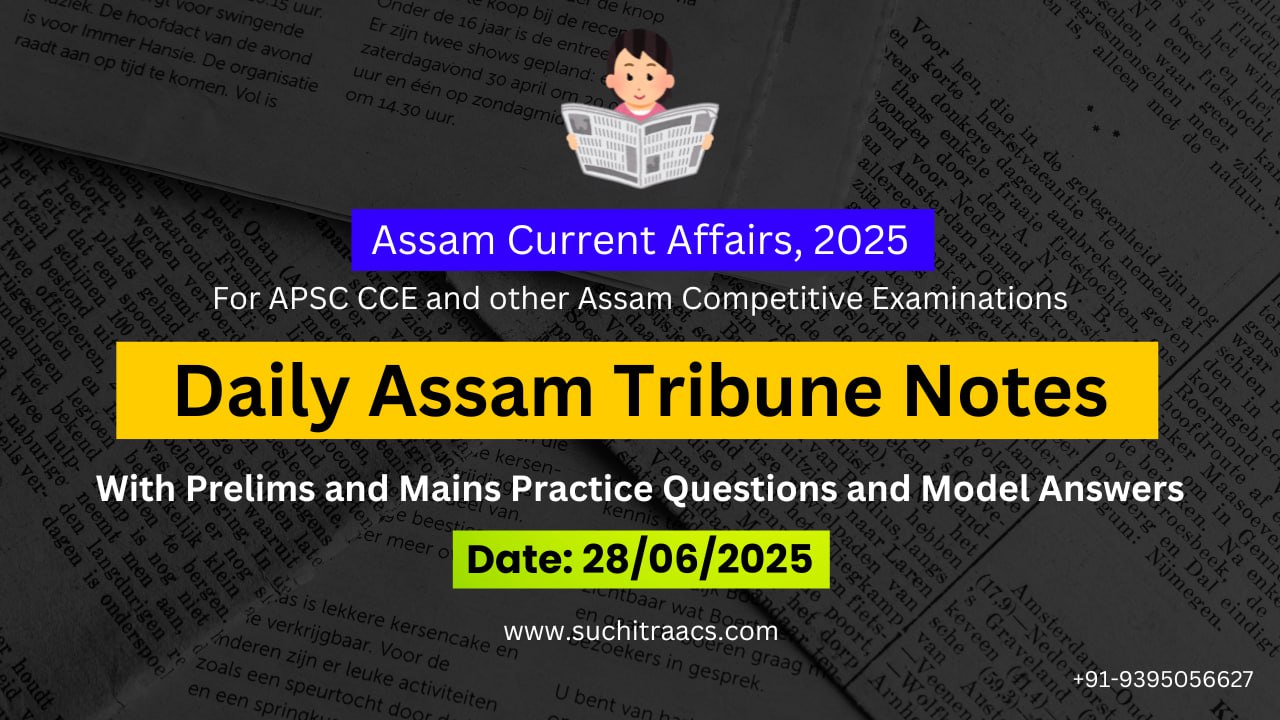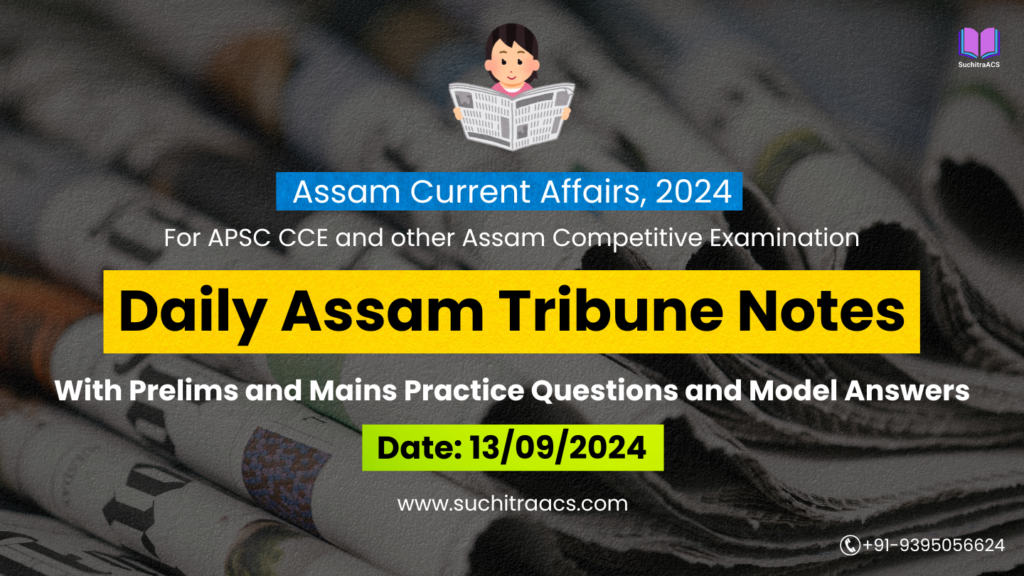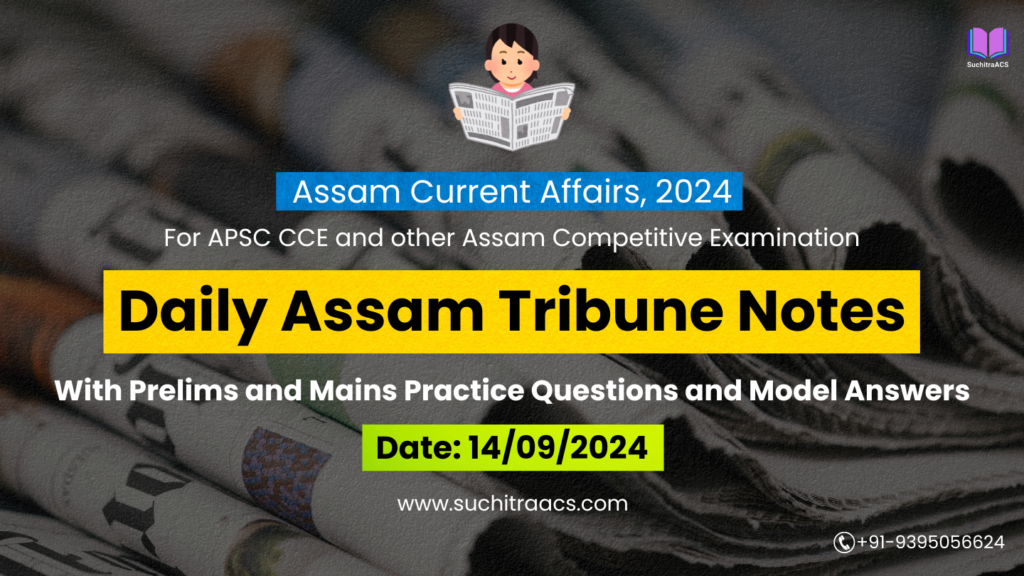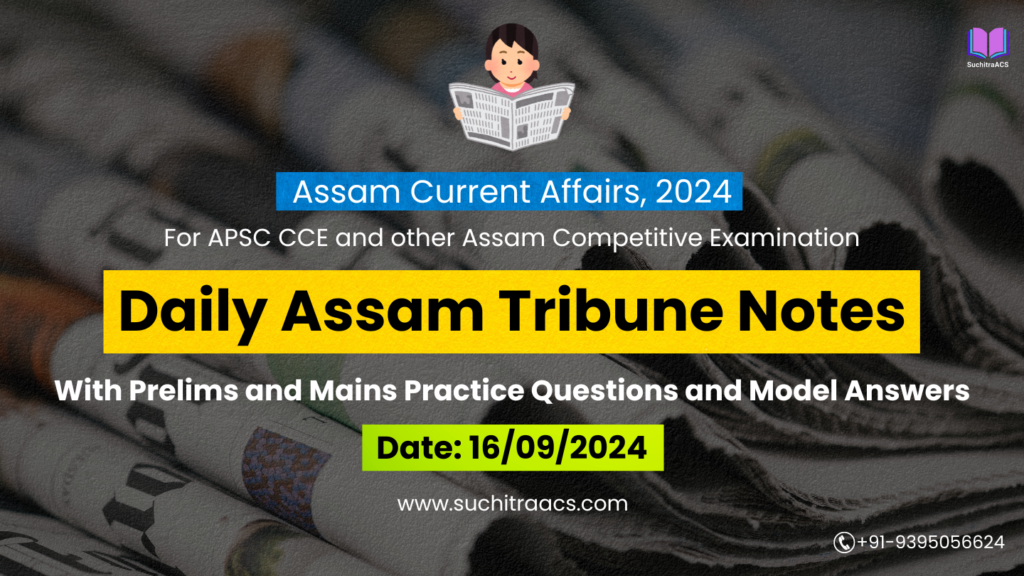APSC Current Affairs: Assam Tribune Notes with MCQs and Answer Writing (28/06/2025)
For APSC CCE and other Assam Competitive examinations aspirants, staying updated with current affairs is vital. This blog covers most important topics from the Assam Tribune today (28-06-2025). These issues are key for both APSC Prelims and Mains preparation, offering insights into the APSC CCE Syllabus.
✨ APSC CCE Online Coaching, 2026

🌋 Critical Capping of ONGC Gas Well in Assam: A Case of Crisis Management in Energy Sector
📘 GS Paper 3: Energy | Disaster Management | Infrastructure
📘 APSC GS Paper 5: Assam-Specific Developments | Resource Management
🔹 Introduction
On 27 June 2025, ONGC successfully capped a gas blowout at Well RDS 147A in Rudrasagar oil field, Sivasagar district. This was a high-risk operation involving crisis management, disaster prevention, and energy infrastructure protection.
🔑 Key Points
| Feature | Description |
| Incident | Gas blowout during service ops at Well RDS 147A (Barichuk, Bhatiapar) |
| Operator | ONGC with support from SK Petro Services and Cudd Pressure Control |
| Response Mechanism | Removal of damaged Blowout Preventer (BOP), installation of capping stack |
| Outcome | Gas flow safely redirected and controlled, no casualties or fires reported |
| Government Involvement | Union Minister Hardeep Singh Puri praised the operation |
🧠 Prelims Pointers
Blowout Preventer (BOP): A safety device used to seal, control and monitor oil and gas wells to prevent blowouts.
Crisis Management Protocols: ONGC’s internal safety and emergency action plans aligned with DGMS norms.
Major Oil Fields in Assam: Rudrasagar, Lakwa, Geleki, and Moran (all operated by ONGC).
Sivasagar: A major hub for Assam’s hydrocarbon industry.
📝 Mains Pointers
✅ Importance
| Dimension | Significance |
| Energy Security | Assam’s oil and gas fields are critical for India’s energy supply chain. |
| Infrastructure | Protecting field assets ensures continued operations and investor confidence. |
| Disaster Avoidance | Avoided a potential ecological and human disaster. |
⚠️ Challenges
| Issue | Explanation |
| High-pressure wells | Assam’s wells often have high pressures due to geological conditions. |
| Equipment age and risk | Risk increases with ageing infrastructure. |
| Response time | Quick mobilisation of crisis teams remains a logistical challenge in remote areas. |
🏛️ Government and Institutional Efforts
Ministry of Petroleum and Natural Gas: Actively monitors blowout incidents, ensuring global safety benchmarks.
Assam Govt Role: Provided on-ground coordination and logistical support.
Training and Drills: ONGC and Oil India Ltd regularly conduct mock drills to manage such situations.
🧭 Way Forward
| Measure | Suggestion |
| Digital Surveillance | Use AI and IoT for real-time well monitoring. |
| Well Design Improvements | Upgrade older wells with modern casing and pressure controls. |
| Local Response Teams | Strengthen district-level disaster response units for oil fields. |
| Transparency and Audits | Regular safety audits and public reporting on environmental risks. |
🔚 Conclusion
The successful capping of the ONGC gas well in Assam reflects the synergy between technology, human expertise, and administrative preparedness. It underlines the need for continuous investment in energy infrastructure safety and reinforces Assam’s role as a key player in India’s hydrocarbon economy.
🧪 NIPER Guwahati to Lead Northeast’s Drug Innovation Under National Pharma Mission
📘 GS Paper 2: Government Policies | Health Sector | Education
📘 GS Paper 3: Science & Technology | Research & Innovation | Pharma Sector
📘 GS Paper 5 (APSC): Health Infrastructure in Assam | Innovation in Northeast
🔹 Introduction
The National Institute of Pharmaceutical Education and Research (NIPER), Guwahati, has been designated as the zonal innovation hub for the Northeast under the revamped National Pharmaceutical Mission (NPM). The aim is to integrate drug R&D, traditional medicine validation, biotech incubation, and industry linkages in one regionally anchored model.
🔑 Key Highlights
| Feature | Details |
| 📍 Location | NIPER Guwahati – Changsari Campus |
| 🧪 Designated Role | Zonal Pharma R&D and Innovation Hub for NE |
| 🚀 Mission Involved | National Pharmaceutical Mission (revamped 2025) |
| 🔬 Focus Areas | Drug discovery, AYUSH validation, biotech incubation, lab-to-market pipeline |
| 🤝 Collaborations | IIT-Guwahati, NIPERs, pharma startups, and NE state health departments |
| 🗓️ Launch Year | Formalized under 15th Finance Commission’s special NE grant |
🧠 Prelims Pointers
NIPERs: India’s premier pharma education and R&D institutes; Guwahati is one of 7 across India.
National Pharmaceutical Mission (NPM): Launched by Dept. of Pharmaceuticals to boost domestic innovation, generic drug access, and reduce imports.
Pharma Vision 2047: India aims to be a global pharma innovation and manufacturing hub.
North East Region Industrial Development Scheme (NERIDS): Offers incentives for biotech/pharma firms in NE.
BIRAC: Biotechnology Industry Research Assistance Council supports innovation incubation.
📝 Mains Pointers
✅ Significance for Assam & the Northeast
| Area | Impact |
| 💊 Affordable Healthcare | Region-specific drug R&D can lower cost of medicines |
| 🧬 Biotech Incubation | Supports Assam’s growing health-tech and diagnostics startups |
| 🧘♂️ AYUSH Integration | Validates and commercializes traditional tribal medicine and herbal drugs |
| 👨🔬 Talent Development | Attracts pharma scientists, researchers, and innovators to Assam |
| 📈 Regional Economy | Strengthens Guwahati’s position as a knowledge and innovation hub |
⚠️ Challenges
| Challenge | Explanation |
| 🧪 Limited Ecosystem | Northeast has low pharma industrial density |
| 💼 Faculty Shortage | Skilled researchers often migrate to southern pharma hubs |
| 📦 Commercialization Lag | Lab research often fails to scale up into mass production |
| 🔗 Industry-Academia Gap | Need for stronger partnerships with pharma corporates |
📑 Relevant Policy Context
National Health Policy (2017) – Innovation for accessible and affordable healthcare
Pharma Sector PLI Scheme – Incentivizes bulk drug parks, R&D investments
Draft STIP 2020 – Focus on regional R&D decentralization
Make in India & Startup India – Targeted at innovation-driven sectors
State Biotechnology Policy (Assam) – Supports herbal, diagnostics, and drug research
🧭 Way Forward
| Recommendation | Strategy |
| 🧑🔬 Faculty Exchange with IIT-G | Strengthen joint projects and academic mobility |
| 🌿 Tribal Medicine Labs | Community-led screening of medicinal plants |
| 🚀 Pharma Start-up Grants | NER-specific innovation seed funds via BIRAC |
| 🧭 Skill Hubs | Lab technicians, QC, and pharma supply chain training centers in NE |
| 🔄 Commercialization Units | Tech-transfer cells within NIPER to accelerate market readiness |
🔚 Conclusion
With NIPER Guwahati at the forefront, Assam can emerge as a bio-innovation gateway for the entire Northeast. By harnessing traditional knowledge, biotech potential, and institutional R&D, this initiative supports inclusive, affordable, and regionalized healthcare innovation in India.
⚖️ “Where Not to Commit Murder”: Judicial Inequality and Criminal Justice Disparities
📘 GS Paper 2: Governance – Criminal Justice System | Judiciary | State Capacity
📘 GS Paper 4: Ethics – Justice, Fairness, Inequality | Role of State Institutions
🔹 Introduction
A sharp and evidence-backed editorial titled “Where Not to Commit Murder” highlights alarming disparities in India’s criminal justice system. Drawing on data from the India Justice Report 2024 and recent NCRB trends, the article argues that a person’s fate after committing a crime in India often depends more on geography and state efficiency than on the rule of law.
🔑 Key Issues Raised
| Concern | Details |
| ⚖️ Uneven Prosecution Rates | Conviction rate for murder: 88% in Kerala vs 7.4% in Jharkhand |
| 🏛️ Inequality in Investigative Capacity | Vacancies: Over 25% in police, 35% in prosecution in some states |
| 🕐 Judicial Delay | Case pendency: Average 7+ years in lower courts |
| 📊 Data Cited | India Justice Report (2024), NCRB crime data |
| ⚠️ Geographic Arbitrage of Crime | The probability of conviction varies dramatically across states |
🧠 Prelims Pointers
India Justice Report: Released by Tata Trusts & Centre for Social Justice; tracks police, judiciary, legal aid, prison capacity
NCRB (National Crime Records Bureau): Maintains crime statistics including conviction and pendency rates
Article 14: Right to equality before law
Article 21: Right to life and personal liberty – includes speedy trial (per SC in Hussainara Khatoon case)
Criminal Justice System Components: Police → Prosecution → Judiciary → Prison
📝 Mains Pointers
A. Governance Implications
| Concern | Explanation |
| 🚨 Arbitrary Justice Delivery | Similar crimes receive very different outcomes across states |
| 🧑⚖️ Undermined Rule of Law | State capacity failure distorts faith in justice |
| ⚖️ Inequality Before Law | Poor and rural citizens face weaker legal protections |
| ⏳ Delayed Trials | Undermine deterrence and rehabilitation |
| 🔁 Vicious Cycle | Low conviction → low trust → fewer reports → impunity |
B. Ethical Dimensions (GS Paper 4)
| Ethical Concern | Illustration |
| 🧭 Fairness & Equity | Justice must be consistent, not state-dependent |
| 🛡️ Responsibility of State | Moral obligation to ensure uniform legal safeguards |
| 🧑⚖️ Integrity in Policing | Accountability of police and prosecutors is crucial |
| ⚖️ Ethics in Public Institutions | Bias, inefficiency, and discretion must be checked |
📑 Related Reforms and Policies
Model Police Act (2006) – Suggested police reforms; mostly unimplemented
Criminal Law Reforms Committee (2020) – Proposed overhaul of CrPC and IPC
Fast Track Courts – Limited success in reducing pendency
E-Courts Mission Mode Project – Enables digital case tracking, slow rollout in rural courts
Legal Services Authorities Act, 1987 – Right to free legal aid
🧭 Way Forward
| Reform Direction | Suggestion |
| 📊 Justice Dashboards | Public, real-time reporting of pendency, conviction by state |
| 🧑⚖️ Judicial Cadre Expansion | Fill judge and prosecutor vacancies under SC supervision |
| 🛡️ Police & Prosecution Autonomy | Insulate from political interference |
| 🧑🎓 Legal Awareness Campaigns | Public education on rights, especially in low-capacity states |
| 🧬 Justice Ecosystem Federalism | Center should support lagging states with targeted judicial funding |
🔚 Conclusion
The principle of “equality before the law” is hollow if justice varies based on geography. To uphold constitutional morality, India must reform its criminal justice system to be uniform, efficient, and accessible to all citizens—regardless of which state they reside in.
APSC Prelims Practice Questions
✅ Topic 1: ONGC Successfully Caps Gas Blowout in Assam
1. What is a Blowout Preventer (BOP) commonly used for?
A. Controlling refinery emissions
B. Preventing underwater corrosion in oil rigs
C. Monitoring gas storage pressure
D. Sealing and controlling oil/gas well pressure during drilling ✅
🧠 Explanation:
A Blowout Preventer (BOP) is a crucial safety device used to seal, control, and monitor pressure in oil and gas wells to prevent uncontrolled release, i.e., blowouts.
2. Which of the following districts in Assam are known for major ONGC oil and gas operations?
- Sivasagar
- Dibrugarh
- Tinsukia
- Barpeta
Select the correct code:
A. 1 and 2 only
B. 1, 2 and 3 only ✅
C. 2, 3 and 4 only
D. All of the above
🧠 Explanation:
Sivasagar, Dibrugarh, and Tinsukia are major hydrocarbon hubs. Barpeta is not associated with ONGC’s oil/gas extraction.
✅ Topic 2: NIPER Guwahati Designated as NE Pharma Innovation Hub
3. The National Institute of Pharmaceutical Education and Research (NIPER) in Guwahati has recently been designated as:
A. North East’s medical college accreditation body
B. Regional nodal center for Ayurveda research
C. Zonal pharma R&D and innovation hub ✅
D. Emergency drug distribution center for NE
🧠 Explanation:
NIPER Guwahati was officially named the zonal innovation hub for pharmaceutical R&D under the revamped National Pharmaceutical Mission (2025).
4. Which of the following statements about the National Pharmaceutical Mission (NPM) is/are correct?
- It promotes indigenous drug discovery and development.
- It is implemented by the Department of Pharmaceuticals.
- It aims to reduce India’s import dependence on bulk drugs.
Select the correct answer:
A. 1 only
B. 1 and 2 only
C. 1 and 3 only
D. 1, 2 and 3 ✅
🧠 Explanation:
All three are objectives of the National Pharmaceutical Mission, including promotion of innovation, drug security, and local manufacturing capacity.
✅ Topic 3: “Where Not to Commit Murder” – Judicial Inequality in India
5. Which of the following Supreme Court judgments held that the “right to a speedy trial” is a fundamental right under Article 21?
A. A.K. Gopalan v. State of Madras
B. K.S. Puttaswamy v. Union of India
C. Hussainara Khatoon v. State of Bihar ✅
D. Maneka Gandhi v. Union of India
🧠 Explanation:
In Hussainara Khatoon v. State of Bihar (1979), the Supreme Court ruled that speedy trial is an essential part of Article 21 – the Right to Life and Personal Liberty.
6. The India Justice Report evaluates Indian states based on which of the following pillars?
- Police
- Judiciary
- Prosecution
- Prisons
Select the correct code:
A. 1, 2 and 4 only
B. 1 and 3 only
C. 1, 2, 3 and 4 ✅
D. 2 and 4 only
🧠 Explanation:
The India Justice Report, released by Tata Trusts and partners, ranks states on the performance of four pillars: police, judiciary, prosecution, and prisons.
APSC Mains Practice Question
📝 Mains Question:
“The Indian criminal justice system often delivers unequal outcomes depending on geography. In light of this, critically examine the factors leading to judicial inequality and suggest measures to ensure uniform access to justice across states.”
Introduction
The principle of “equal protection of law” enshrined in Article 14 of the Constitution is fundamental to Indian democracy. However, recent findings from the India Justice Report 2024 and analyses like “Where Not to Commit Murder” reveal that outcomes in criminal trials vary sharply across Indian states, challenging the ideal of uniform justice delivery.
Judicial Inequality Across States – Key Indicators
| Metric | Example |
| Conviction Rate for Murder | Kerala: 88% vs Jharkhand: 7.4% |
| Prosecution Vacancies | Over 30% in multiple states |
| Case Pendency | NE and Bihar: >7 years average in lower courts |
| Prison Overcrowding | States like Uttar Pradesh >150% capacity |
| Legal Aid Access | Varies significantly by state capacity and awareness |
Factors Leading to Inequality
| Factor | Explanation |
| 🛑 Inadequate Infrastructure | Shortage of courtrooms, judges, forensic labs |
| 🧑⚖️ Vacancy in Key Roles | Prosecutors and judicial officers often unfilled for years |
| ⚖️ Police-Prosecution Gap | Weak coordination reduces case quality |
| 📊 Lack of Data-Driven Reform | State-specific justice dashboards are rare |
| 🌐 Digital Divide | Poor e-court access in rural/tribal districts |
Ethical and Governance Implications
| Principle | Violation |
| ⚖️ Rule of Law | Eroded when law functions inconsistently |
| 🧭 Justice & Fairness | Victims and accused face arbitrary outcomes |
| 🔍 Public Trust | Declines due to prolonged or biased trials |
| 🧑💼 State Responsibility | Fails to uphold minimum standards of justice delivery |
Steps Taken So Far
- Fast Track Special Courts for sexual offences (POSCO, rape cases)
- E-Courts Phase II: Case listing, video conferencing enabled
- NCRB Digitisation: FIR and case tracking being streamlined
- Legal Services Authorities Act (1987) – Legal aid for poor, though unevenly implemented
- Criminal Law Reforms (2023 Bills) – Aims to overhaul IPC, CrPC, Evidence Act
Way Forward
| Recommendation | Strategy |
| 👨⚖️ Fill Judicial Vacancies | National-level monitoring via NJAC-like body |
| 📈 Real-time Justice Dashboards | Public data on pendency, conviction, judge ratio |
| 🎓 Legal Literacy Drives | Especially in backward and tribal areas |
| 🔗 Police-Prosecution-Judiciary Link | Integrated case management systems |
| 🧑💻 Tech Access in Rural Courts | Digital infra + paralegal support in backward districts |
Conclusion
Justice must not be determined by which Indian state one resides in, but by the uniform application of law. Judicial inequality strikes at the heart of constitutional morality. India must urgently reform and invest in its criminal justice ecosystem to uphold the promise of “justice for all”, not just a privileged or better-governed few.
✨ APSC CCE Courses, 2025-26 offered by SuchitraACS


🔔 Join Our WhatsApp Study Group!
For exclusive access to premium quality content, including study materials, current affairs, MCQs, and model answers for APSC CCE and other Assam competitive exams.
Click here to join: SuchitraACS Study WhatsApp Group
📚 Want to know more about SuchitraACS’s most affordable courses?
Click here to know more: SuchitraACS Courses for APSC CCE and Assam Competitive Examinations




